Technology
101 AI Statistics You Should Know in 2024

Artificial Intelligence (AI) is redefining and disrupting the way we handle various tasks, from shopping and search experiences to customer support and beyond. Check out this blog on artificial intelligence statistics for 2024, which covers the impact AI has made and will continue to make in the future, along with predictions.
Artificial intelligence (AI)! What’s the first thought that came to your mind? Intelligent robots taking over the world? Duh, that’s all science fiction! Then what’s the reality? It’s all about AI becoming an intelligent helping hand for humankind, especially in the segment of business. You can say, AI has become more than just a buzzword in today’s world and is being applied everywhere.
That’s the bright side, but on the dark side, it also has its disadvantages if this AI power is not in the right hand. Well, somehow, we all are aware of the wonders of this artificial intelligence technology. But what about the numbers that it has helped businesses achieve through different use cases? That’s also deep down we all know!
But surety is a must! Hence, let’s check out this rundown of Artificial Intelligence statistics that can help learn more about the effectiveness of this technology and be sure about the solution your business needs to thrive in this technology-driven competitive business landscape.
Editor’s Pick On Artificial Intelligence Statistics
Let’s have a look at our top picks on artificial intelligence facts and statistics at your quick help for further decision-making:
- The global market size of Artificial Intelligence is projected to grow to $826.70bn by 2030 at a CAGR of 28.46% (2024-2030).
- By 2025, around 85 million jobs will be disrupted by automation and the new alliance between humans and machines across 15 industries and 26 economies for job roles including data entry, accounting, and administration mainly as automation (AI) and digital transformation take place.
- As per Cisco’s survey, 83% of executives think AI is a top priority in their business plans today, and 75% find AI as their gateway to shift into new businesses and ventures.
- The major shift in workloads done by AI and automation may result in the automation of 300 million full-time job functions.
- The 2023 Emerging Technology Survey reveals that around 73% of US companies have already adopted AI for some of their business functions.
- The US AI market is forecast to reach $223.70 billion by 2030, with the AI market expanding at a CAGR of 28.30% between 2024 to 2030.
- After one year of the chatGPT, around 54% of businesses have implemented GenAI for its business-specific functions.
- 75% of generative AI users are using it to automate their tasks and communications, while 38% are using it for fun and 34% finding it as an easy gateway to learn about topics.
- 46% of U.S. adults think AI systems are being developed too fast and can take their approach to deal with routine practice to the next level.
The Evolution of Artificial Intelligence
Is AI today’s product? Nah! It has been here since the 1950s – yes, from the time of the father of modern computer science – Alan Turing. Don’t worry, we’ll not go that deep into the history of artificial intelligence, but surely having a glimpse of what we’ve thought of it and what it is now, creates a major difference.
Let’s have a look at the AI adoption statistics as per different timelines:
The Impact of AI In Its Early Era
This era was all about the discovery of AI magic, yet excelled at laying the robust groundwork for what AI is today!
Artificial Intelligence Is the Technology of Now
The current landscape of Artificial Intelligence shows the mixer of excitement and apprehension. Check out Artificial Intelligence growth statistics:
- Around 44% of organizations are in the progress of implementing AI into their existing business applications and processes.
- In competition to boost AI technology research and development, the United States and China top the list. Moreover, 60% of top-tier researchers work for American entities and have raised funds of around $249 billion to date. On the other hand, China has 11% of the top-tier AI researchers and has received $95 billion of investment only in the duration of 2022-2023. These two regions – China and North America, together produce 70% of the global economic impact.
- 81% of office workers hold a favorable view of AI, believing it positively affects their job performance and overall work experience.
What The Future Holds: Statistics About Artificial Intelligence
Let’s have a look at the future of AI statistics:
- As per the PWC report, by 2030, AI can expand its contribution to the global economy with a business opportunity of $15.7 trillion.
- 55% of global organizations are projected to adopt AI by 2025.
- 42% of enterprise-scale businesses have integrated AI and found actively using AI in their operations, and 40% are exploring options with the AI capabilities to harness for their organizations.
- A study by Accenture predicts that AI could double economic growth rates in 12 developed economies and boost labor productivity by 40% by 2023.
- In Climate AI research, Capgemini estimates that AI can contribute to a 16% reduction in GHG emissions and a 15% increase in power efficiency in the following couple of years.
- A recent study by Alteryx suggests that by 2030, up to 34% of AI and machine learning development jobs could be transformed or absorbed by even more advanced AI assistants.
- WNS, a research firm, conducted a survey in 2023 and revealed that 76% of data and analytics leaders plan to implement or are already working on generative AI projects within their organizations.
- Mordor Intelligence estimates the market value at $25.10 billion in 2023 and forecasts a Compound Annual Growth Rate (CAGR) of 52.17%, reaching a staggering $204.79 billion by 2029.
AI Adoption Across Industries
Let’s check out the impact of AI across industries with statistics that your business may find useful:
Healthcare
When it comes to talking about AI in healthcare, we have many expectations with this technology, and the evolution of it has also matched such somewhat. Let’s check out some of the popular AI in healthcare statistics you may find helpful:
- As per Statista, AI in healthcare market size is expected to rise at a CAGR of 38.5% from 2024-2030, which was last estimated at $19.27 billion in 2023.
- One Microsoft-IDC study revealed that around 79% of healthcare organizations currently have AI solutions in place and achieved an ROI of around $3.20 per $1 spent in AI.
- With voice AI getting traction in other industries, healthcare is also finding opportunities in it with a market size to annually grow at a CAGR of 37.3% from 2023-2030.
- One report shared that around 30% of nursing administrative tasks can be done with the help of AI, to devote some more time to better patient care.
- As per one survey, 52% of respondents agree with AI improving healthcare diagnosis, while 32% support better procedural accuracy and 31% support it can help to free up some time to focus on patient care.
BFSI
When it comes to finding better digital transformation in banking, why should this BFSI sector be left behind? AI in Finance has enabled this sector with many compelling solutions that may transform the way this sector is working. So, let’s explore some of the best AI in Banking statistics that you may find helpful.
- As per Grand View Research, Artificial intelligence in the banking market size was last estimated at $19.87 billion in 2023 and is expected to reach $143.56 billion by 2030 at a CAGR of 31.8% (for the forecasting period 2024-2030).
- In the year 2023, the financial sector invested around $35 billion in AI, whereas banking invested around $20.6 billion in AI.
- Grand View Research states that the market size of AI in Fintech is projected to reach the worth of $41.16 billion by 2030 at a CAGR of 16.5%.
- AI has the potential to automate around 20% of banking and financial activities, as revealed in the Wifitalent report.
- Around 81% of banks have plans to use AI to offer better customer services within 12-18 months.
- More than half (50%) will utilize it for enhancing risk management, optimizing back-office operations, and ensuring compliance with regulatory reporting requirements, reveals Qorus-AWS-banking-report-2024.


Retail & Ecommerce
Let’s explore some of the latest Artificial Intelligence statistics revealed from the retail & e-commerce use cases:
These three are the major adopters of AI, creating an impact by offering better services and excelling at their operations and services.
Popular Use Cases of AI
When talking about AI for businesses, you do want to know statistics about artificial intelligence applications which are widely adopted.
Virtual Assistance
Virtual assistants are AI-powered agents that use NLP and machine learning to interact with users, found in various devices like smartphones and chatbots. They streamline tasks, boost productivity, and offer personalized assistance. Understanding proven statistics is crucial for successful implementation in business applications, ensuring improved user experience and product/service success.
As per Grand View Research, at global level, intelligent virtual assistant market size is expected to grow at a CAGR of 24.3% by 2030.
When we think of Virtual Assistants, we think of Siri, Alexa, Bixby, Google VA, etc. But do you know which virtual/voice assistant is more popular among users? If looking from different country perspectives, then virtual assistant usage is as mentioned below:
- In the US: Alexa is used by 34%, Siri by 27%, and Google Assistant by 31%.
- In the UK: Alexa has usage of around 46%, Siri by 26%, and Google Assistant by 24%.
- In Germany: Alexa with 31% usage, Siri with 19%, and Google Assistant with 22% usage.
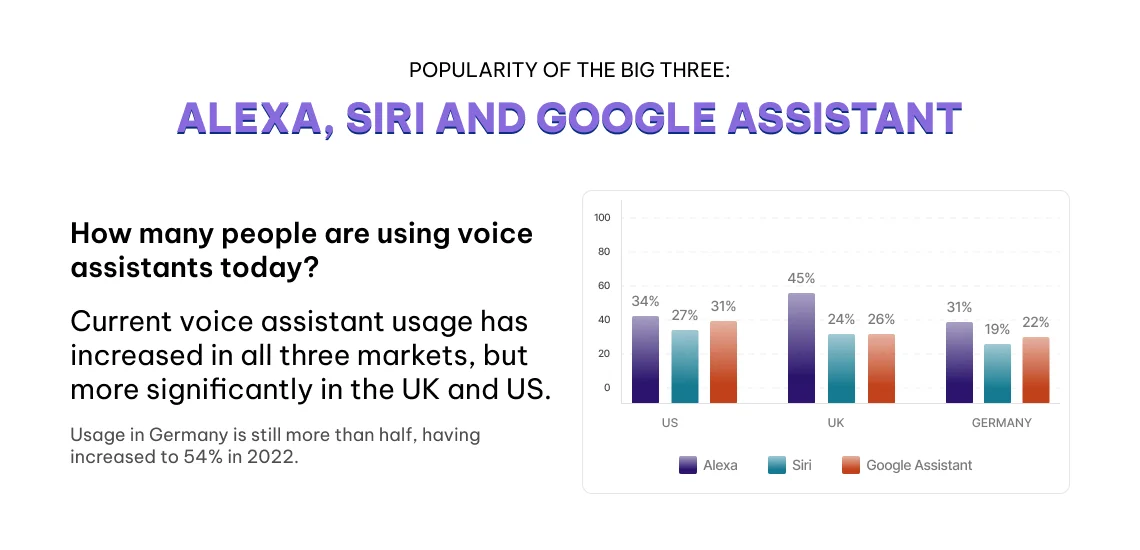

If speaking about using such virtual assistants, then one survey reveals that around ⅗ people (61.4%) use this type of AI application for personal work, while ⅓ people (28.9%) use for their professional work purposes.
If targeting to implement virtual assistants in your products then you should consider the below statistics to find your target audience:
- As per the IDAP research, around 97% of mobile users use AI-powered voice assistants for their personal and professional reasons.
- 62% of Americans use voice assistants to search for something and of them 35% are using it to access their media from smart speakers.
- Around 21% of users use voice assistants as a part of their weekly habits.
- Around 14% of users between the age group of 41-60 years old use virtual assistants weekly.
- Around 25.3% of users between the age group of 18-25 years old use virtual assistants weekly.
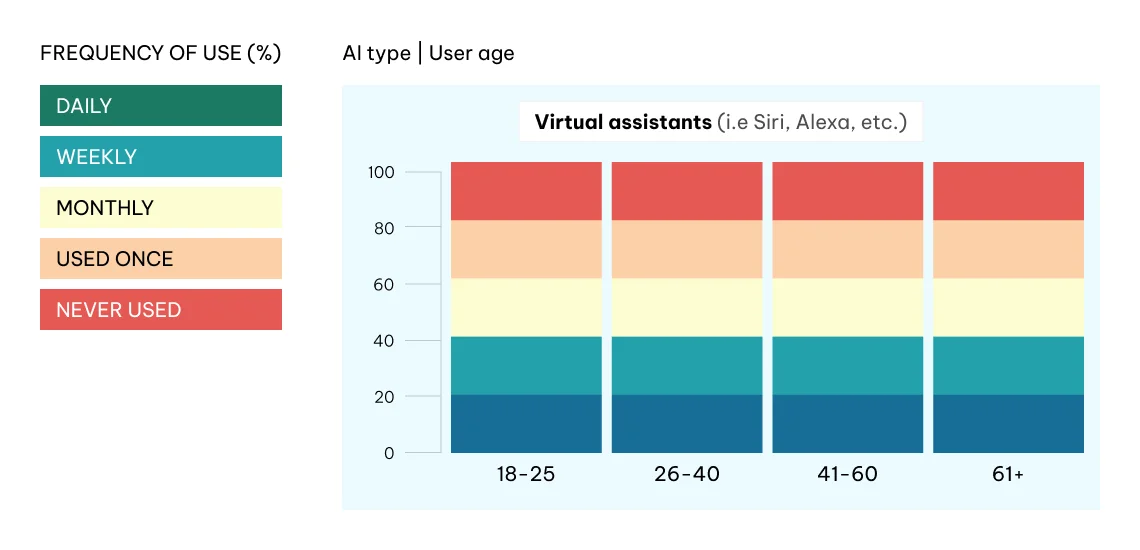

One Statista survey reveals that by 2024, there will be 8.4 billion units supporting digital voice assistants, which is a greater number than the total population of the world.
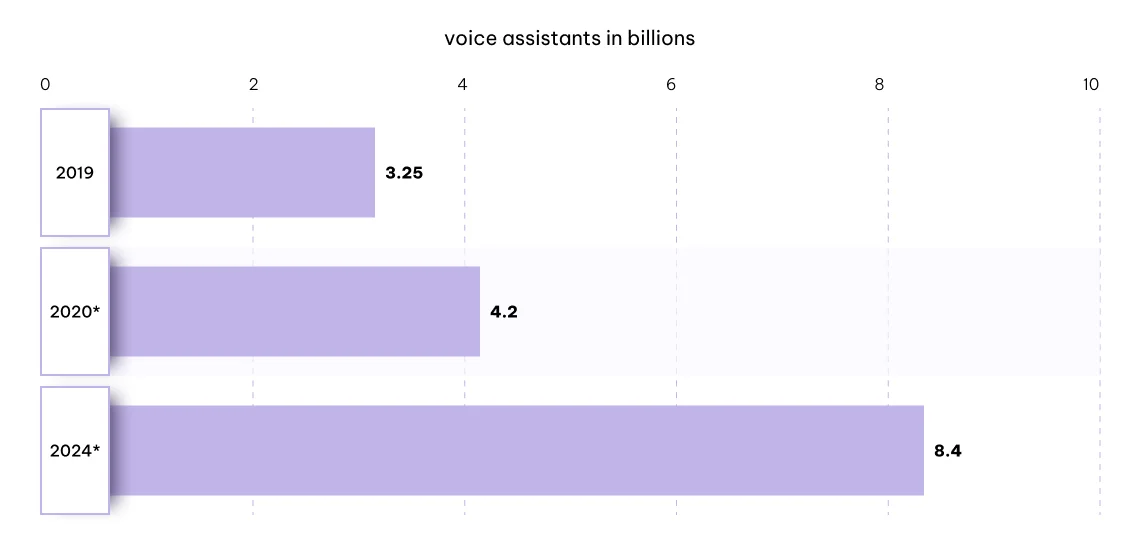

If speaking about voice assistants used from different devices then Alexa tops the charts in the category of smart speakers among other voice assistant search platforms as mentioned in the below image:
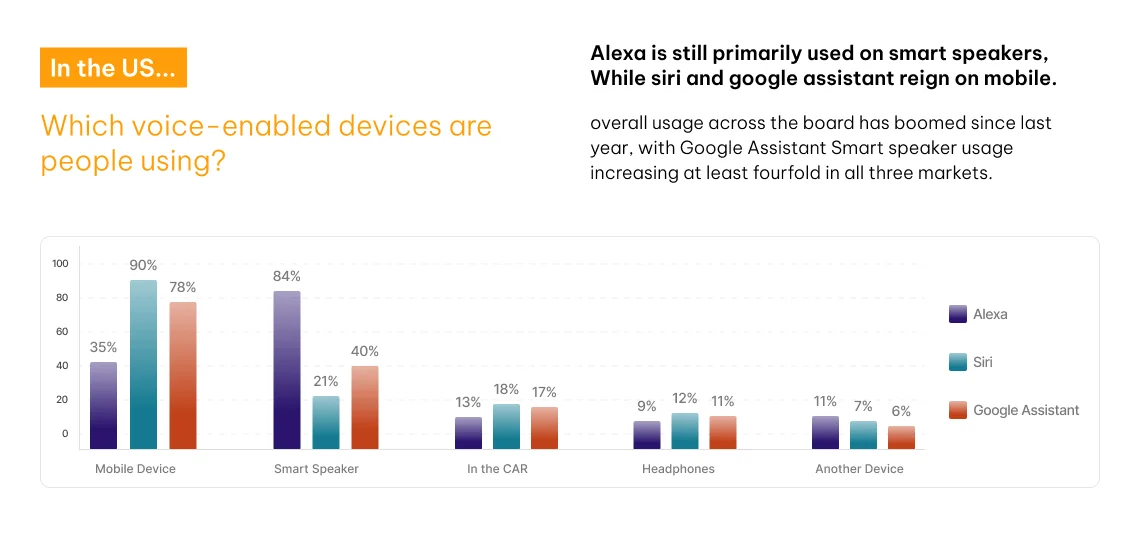

One report reveals that around 54% of users have shown their affirmation that digital assistants will make their lives easier than typing the whole prompt to get the results.
These AI statistics about virtual assistants can help you make your decision about integrating this virtual assistant into your product like it helped our clients – AirAsia and I.AM+.
Recommendation Systems
Businesses running ad campaigns target users based on their search behavior, showing ads across platforms. This personalized advertising, seen on search engines and apps, is powered by AI, like Netflix predicting viewer preferences and Spotify auto-playing songs based on individual music tastes.
MARKET SIZE
As previously checked, the market size of the recommendation engine was valued at $2.7 billion in 2021, but based on its popularity and adoption, industry experts and analysts have projected its market size growth to $43.8 billion by 2031 at a CAGR or 32.1%.
USAGE AND ADOPTION
AI recommendation engines are widely used in various domains, including e-commerce, media and entertainment, social media, healthcare, financial services, and travel and hospitality
On average, 12% of customers’ overall purchases are attributed to AI recommendations.
REVENUE IMPACT
- Choice account for up to 31% of ecommerce revenues, with an average of 12% of customers’ overall purchases attributed to them.
- A McKinsey report also states that personalization can contribute to around 10% – 15% of boost in sales conversion and winning loyalty of customers.
- If the recommendation engine is implemented strategically, it has the potential to increase order rate by 150%, overall site conversion by 13%, and lower business website bounce rate by 24% – achieved by Algolia.
- You’d be amazed to know that around 80% of Netflix users watch movies and shows as suggested by its recommendation algorithms. This is the reason why this trend of binge-watching has given rise to the Netflix and Chill era. Netflix also claims that its algorithmically-generated recommendations influence 80% of its viewership, contributing to a revenue generation of 9.4 billion U.S. dollars as of the latest (2024 first quarter).
So, when creating your Netflix-like OTT app, you must consider adding a recommendation engine as its promotional feature.
After Netflix another giant in the media and entertainment world is Spotify that makes the most use of AI especially its application – Recommendation engine.
In short, recommendation engines are like loyalty boosting and revenue-driving factors that you must add to your e-commerce app, on-demand services-based app, and other apps where users should get personalized services.
Computer Vision
From OCR to human detection with annotations, computer vision has wider applications across industries and is benefiting businesses in various ways. Let’s check out the artificial intelligence statistics for its application called computer vision that might interest you.
- The global computer vision market is projected to reach $25.80 billion in 2024 and is estimated to reach a staggering $46.96 billion by 2030 at a CAGR of 10.50%.
- The segment of PC-based computer vision systems secured the largest market share of 61.7%, with revenue of $7.2 billion in 2021.
- Speaking about computer vision for the quality assurance and inspection segment, it has also acquired a market share of 17.3% with a revenue of $2.02 billion.
- If talking about the sector adopting computer vision, then retail has been a major adopter of it. One study shows that around 64% of retailers are deploying computer vision solutions for better inventory management, and this adoption will grow in the next few years.
- Studies have shown that computer vision algorithms can outperform humans in specific tasks. There’s one DeepMind AI program called AlphaFold, which has achieved 95% accuracy in protein structure prediction, a task previously challenging for human scientists.
Speaking of computer vision in bio and food science, we also have implemented one computer vision-based Nutrition AI – powered by Passio.AI that allows users to scan their food portions and get insights on the nutrition they are about to consume.
- According to the search results, 77% of manufacturers consider computer vision to be a critical technology for achieving their business objectives.
- Speaking about the role of computer vision in traffic management, cities with more traffic often find it difficult to maintain traffic regulations. Considering that researchers used technologies and models like vehicular cloud computing (VCC) + IoT-aided robotic (IoRT) + two deep learning techniques based on modified LeNet-5 for real-time traffic sign recognition + computer vision and created a solution which was tested Extended German Traffic Sign Recognition Benchmark (EGTSRB) and achieved the accuracy of 99.12-99.78% and outperformed traffic sign recognition by 3.78% and traffic light detection and recognition by 1.02%.
- In medical science, traditionally, analyzing imaging and classifying tumors can take up to 40 minutes. Thankfully the invention of AI and ML technologies and their integration with MRI images can help to get the results within a few minutes. One study reveals that one AI-powered solution using computer vision with MRI-scanned images can help to analyze and classify brain tumors with 98.56% of accuracy.
Generative AI
After the commencement of advanced AI tools like ChatGPT, Bard (now Gemini), etc., Generative AI became a hot favorite topic of today’s world, especially in corporates. Now, every business wants to invest in Generative AI development to fuel their productivity and better work experience.
MARKET SIZE
- In banking, this technology can help to generate revenue of $200 billion to $340 billion annually if fully implemented. (Source: McKinsey)
- In retail and FMCG, it can help to generate revenue from $400 billion to $660 billion annually. (Source: McKinsey)
The overall generative AI market is expected to grow by leaps and bounds to $206.95 billion by 2030.
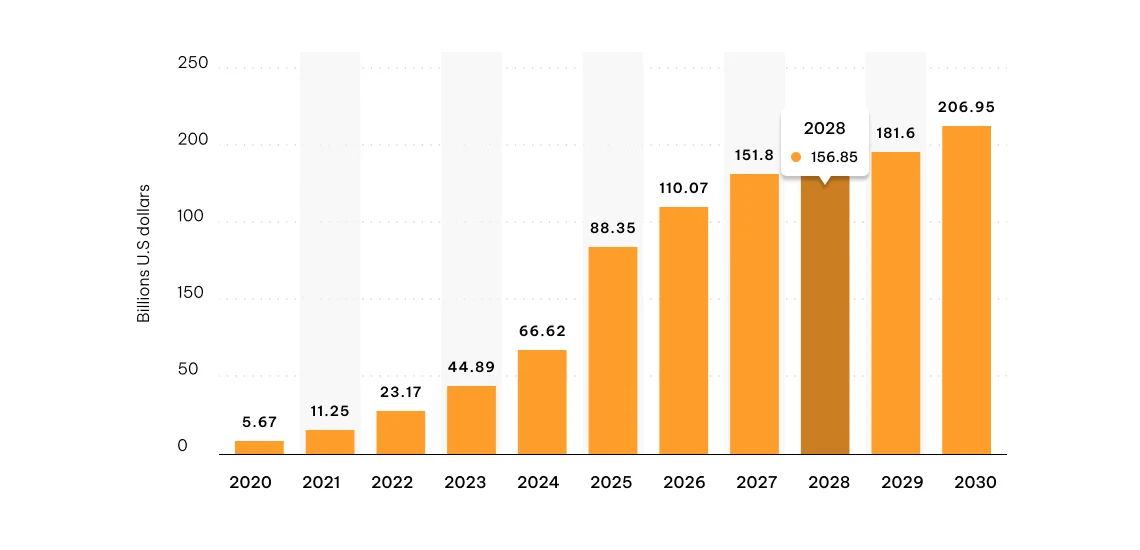

USER STATISTICS
- If you check for the Generative AI users, the majority 65% are Millennials or GenZ, among which 72% are employees.
- It doesn’t end with that – among those, 70% of Gen Z are using it extremely, and 52% even found trusting this technology providing useful information for making informed decisions.
- Want to get some information from Generative AI about any topic? Then, the prompt is the answer. Speaking of which, every 6 out of 10 people confidently say that they are on to mastering to use this technology to the fullest extent.
- If considering the usage of Generative AI across countries, then India leads the way with 73% population using this technology, followed by 49% of the Australian population, 45% of the US population, and 29% of the UK population.
USE CASE STATISTICS
Generative AI is not only related to advanced chat applications, it has more applications than this, some of the popular ones include:
- With AI, automation is the aspect we all want, and hence, 75% of users use Generative AI to automate their tasks at work and even for work communications.
- While 38% of Generative AI find it as a platform to have fun or mess around, 34% find learning opportunities for topics they are interested in.
- If talking about marketing experts, then around 73% of them use Generative AI tools to produce content.
- When Botco surveyed 1000 marketing professionals, they discovered 55% excessively use ChatGPT, 42% use Copy.AI, 36% use Jasper.AI, 25% use DALL-E, 24% use MidJourney, etc.
- In the talk about software development, around 95% are found using AI to generate code and fix code bugs to create software applications.
ABILITY AND IMPACT
- One McKinsey survey revealed that Generative AI has the potential to boost the impact of AI by 15-40%.
- Claud – An Anthropic’s generative AI’s capability initially (March 2023) was around processing 9,000 tokens of text, but when last tested in May 2023, it’s capability increased to 100,000 tokens of text (which is around 75,000 words) and could process correct answers in just 22 seconds.
- Generative AI has a direct proportional impact on labor productivity, which can increase from 0.1 to 0.6% by 2024. (McKinsey)
- Combining Generative AI with other cutting-edge technologies may potentially add productivity growth annually by 0.5 to 3.4% with work automation. (McKinsey)
- 67% of marketing professionals find Generative AI helpful for enhanced content creation process as it has the potential to decrease their workload by nearly 60%.
- Generative AI and content creation are the things we are confident about for this technology and around 82% of marketing professionals also show their affirmation that AI-powered content creation is as effective as human-produced ones.
Indeed, Generative AI is pushing the boundaries of creativity with its power for content creation, code generation, media generation, polishing, and becoming a personal AI assistant.
Cybersecurity
With AI pushing its limits, hackers are getting smart with expanding their usage of AI for their ulterior motives to breach systems that could benefit them.
Hence, it’s a must to integrate AI into your cybersecurity practices to outsmart these hackers. Below are the statistics about artificial intelligence (AI) in cybersecurity you must know:
- If we talk about the AI in cybersecurity market size, then experts have forecasted its growth to around $134 billion in 2030 from $24 billion marked in 2023.
- Around 69% of enterprises find AI a necessity to be implemented for cybersecurity standards, considering the increasing number of threats, cybersecurity analysts may need to tackle.
- The median dwell time, which represents the duration between an attacker gaining access to their victim’s systems and the detection or execution of the attack, has seen an average decrease of 15%.
Companies with AI cybersecurity in place have reportedly found saving up $3.05 million of cost saving by avoiding data breaches.


The Impact of AI on the Job Market
The rise of Generative AI has also given rise to new job opportunities, known as Prompt Engineering, which has considerably created many job opportunities, along with job insecurities for many.
Let’s take a look at statistics about artificial intelligence showing the impact it can have on the job market:
- As per the report of the World Economic Forum, AI will create 75 million jobs globally and create 133 million new job roles and opportunities.
- There’s one more prediction about the evolution of AI, which is that by 2030, AI can potentially replace 800 million jobs globally.
- One Bloomberg report shares that over 120 million workers are expected to undergo retraining in the next three years as AI reshapes industry demands.
- After the commencement of Generative AI tools like ChatGPT, around 81.6% of digital marketing professionals, especially content writers are threatened by their job roles being taken over, but in reality, it’s created to augment human creativity and expertise – more like advancing it instead of replacing it.
- Seeing the disruption AI is creating, there are mixed feelings (Negative + Positive) about AI, especially for the job market. Around 53% of people think AI has the potential to spread misinformation about things.
- Taking that further, many think that around 43% of white-collar jobs and 46% of blue-collar jobs will be negatively impacted by AI.
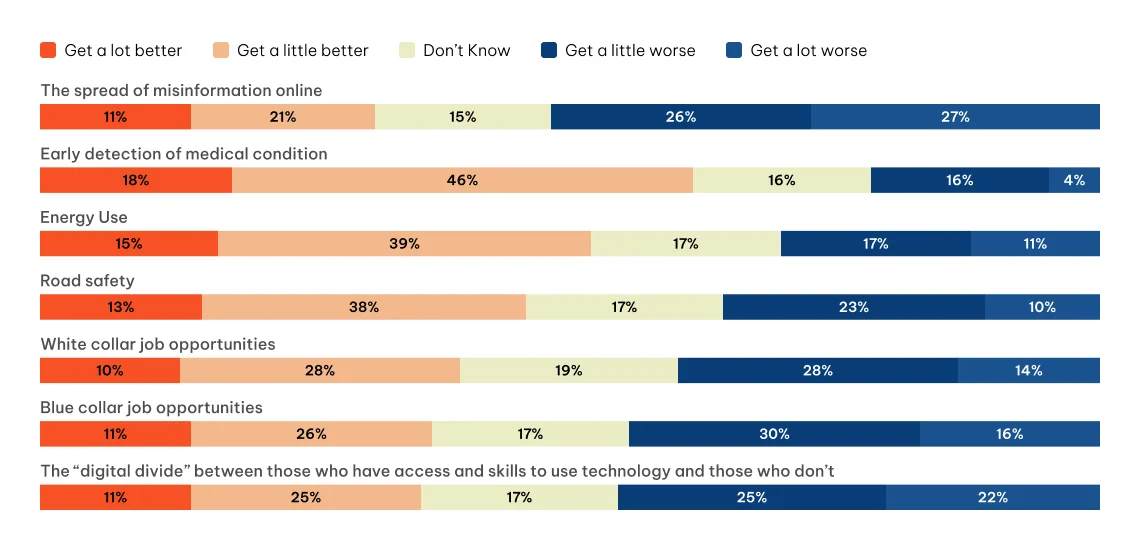

Potential AI Challenges and Predictions
With finding opportunities across domains, it’s also important to know AI statistics about potential challenges it could bring along with some of the power predictions about it raising concerns for businesses.
- When AI is there in the network, security concerns will also be there. As per Mitre’s 2023 survey, around 80% of US adults are worried that AI may be used for cyber attacks, and 78% showed their concern for identity theft by AI effect.
- With Generative AI boosting productivity, it also gets hallucinations of offering accurate information, but it’s not the case all the time. Hence, 56% of companies believe risks associated with the adoption of Generative AI offering inaccurate information. Considering that only less than half of respondents have better systems to mitigate AI risks and inaccuracies.
- With concerns, there’s also a positive ray – 78% of business leaders also have this view that the potential benefits of AI can help to mitigate the risks.
Conclusion
From healthcare to finance, manufacturing to marketing, AI is revolutionizing the way businesses operate, driving efficiency, innovation, and growth. The data underscores the importance of understanding and harnessing AI technologies to stay competitive in an increasingly digital world.
As we continue to explore the potential of AI, it’s essential to prioritize ethical considerations, address challenges, and embrace opportunities for collaboration and innovation. That’s where your AI development services provider comes to your help.
At MindInventory, we help businesses harness the potential of AI technology from strategic & ethical planning with a foolproof roadmap to data science solutions with robust AI-powered digital solutions. Have an AI project in mind for us? Let’s discuss it and find an effective solution that can help you excel in your mission.



